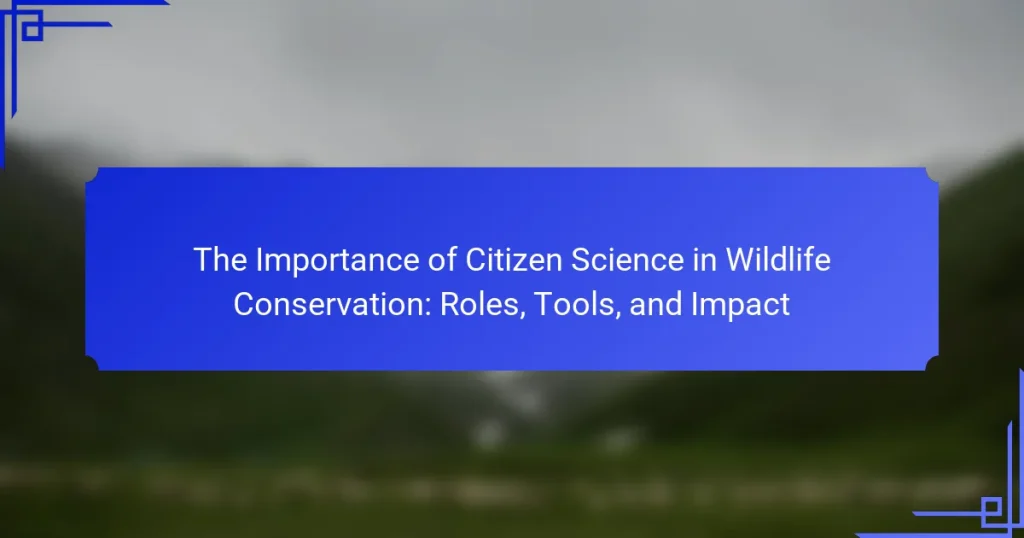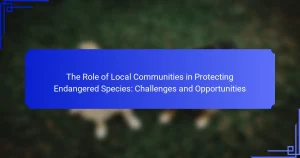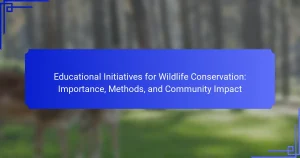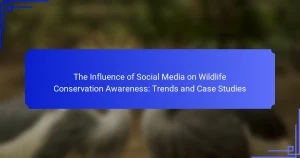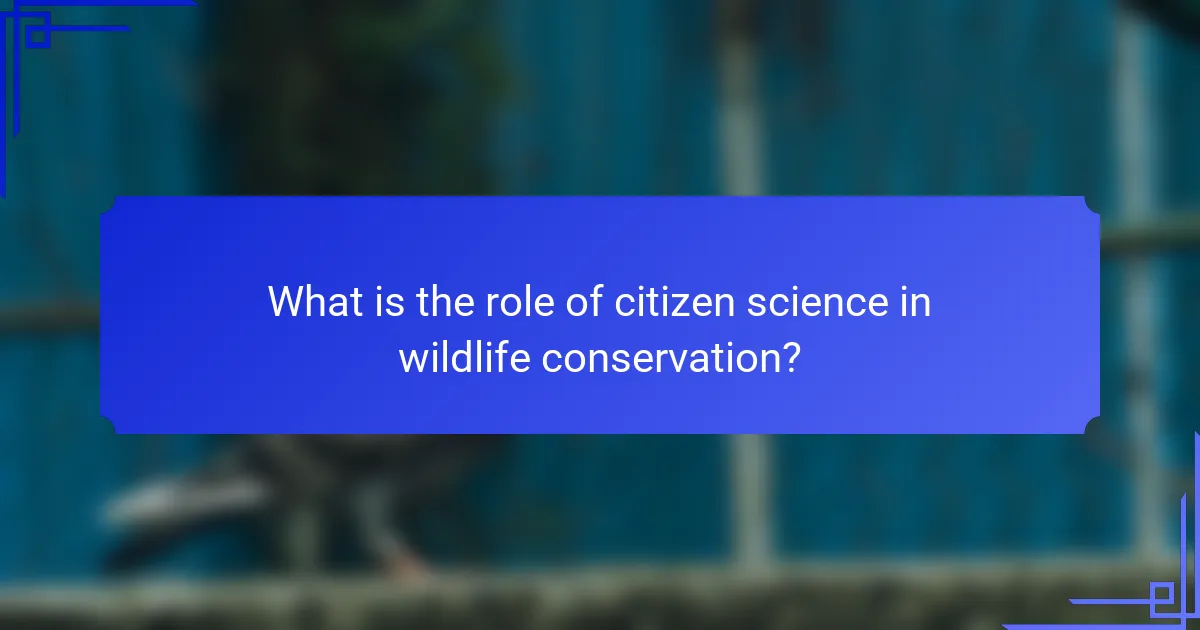
What is the role of citizen science in wildlife conservation?
Citizen science plays a crucial role in wildlife conservation by engaging the public in data collection and monitoring efforts. This participation enhances the volume and diversity of data available for conservation research. Citizens contribute to tracking species populations and behaviors, which can inform conservation strategies. For instance, programs like the Christmas Bird Count have gathered decades of data on bird populations, aiding in understanding trends and threats. Additionally, citizen scientists often raise awareness about conservation issues within their communities. This grassroots involvement can lead to increased funding and support for wildlife protection initiatives. Overall, citizen science strengthens conservation efforts through collaboration between scientists and the public.
How does citizen science engage the public in conservation efforts?
Citizen science engages the public in conservation efforts by involving them in data collection and analysis. This participation fosters a sense of ownership and responsibility towards local ecosystems. Projects often utilize mobile apps or online platforms to facilitate engagement. For example, the Cornell Lab of Ornithology’s eBird program allows birdwatchers to report sightings. This data contributes to large-scale biodiversity monitoring. Studies show that citizen science can significantly enhance data collection efficiency. A report by the National Academies of Sciences indicates that citizen contributions improve scientific research outcomes. This collaborative approach builds community awareness and promotes conservation actions.
What are the key motivations for individuals to participate in citizen science?
Individuals participate in citizen science primarily for personal interest, community engagement, and environmental impact. Many are motivated by a desire to contribute to scientific research. They seek to enhance their understanding of nature and wildlife. Others join to connect with like-minded individuals in their communities. Participation often fosters a sense of belonging and teamwork. Additionally, individuals may wish to influence conservation efforts positively. Research indicates that 90% of participants feel more connected to their local environment through citizen science projects. This engagement can lead to increased awareness of ecological issues and advocacy for conservation initiatives.
How do citizen scientists contribute to data collection and analysis?
Citizen scientists contribute to data collection and analysis by gathering observations and measurements in various research projects. They often participate in wildlife monitoring, biodiversity assessments, and environmental surveys. This involvement increases the volume of data available for scientific study. For example, projects like the Audubon Society’s Christmas Bird Count rely on volunteers to report bird sightings. Their contributions help track population trends over time. Additionally, citizen scientists often use digital tools and apps to record data efficiently. Studies indicate that data collected by citizen scientists can be as reliable as that gathered by professional scientists. This collaboration enhances the overall understanding of ecological changes and conservation needs.
Why is citizen science important for wildlife conservation?
Citizen science is important for wildlife conservation because it engages the public in data collection and monitoring efforts. This participation enhances the volume and diversity of data available for research. Involving citizens allows for broader geographic coverage, particularly in remote areas. Studies show that citizen-collected data can be as reliable as data collected by professionals. For instance, the Cornell Lab of Ornithology’s eBird program has amassed millions of bird observations from volunteers. This data has contributed to significant insights into bird population trends and migrations. Furthermore, citizen science fosters community awareness and education about local ecosystems. Engaging the public promotes stewardship and advocacy for wildlife conservation efforts.
What impact does citizen science have on biodiversity monitoring?
Citizen science significantly enhances biodiversity monitoring. It engages the public in data collection and observation. This approach increases the volume of data available for scientists. For instance, projects like eBird have gathered millions of bird sightings globally. Such extensive data helps identify trends in species populations. Citizen contributions can cover large geographic areas often inaccessible to researchers. This democratizes data collection, allowing for diverse input. Studies indicate that citizen-collected data can match the quality of professional data. This collaboration fosters greater public awareness and involvement in conservation efforts.
How does citizen science enhance public awareness and education about wildlife issues?
Citizen science enhances public awareness and education about wildlife issues by actively involving individuals in data collection and research. This engagement fosters a deeper understanding of local ecosystems and species. Participants often learn about biodiversity, conservation methods, and ecological threats. Research shows that citizen science projects, such as the Cornell Lab of Ornithology’s eBird, have significantly increased public knowledge about bird populations. Additionally, these initiatives provide accessible platforms for sharing findings, making scientific information more relatable. By contributing to real-world data, citizens feel a sense of ownership and responsibility toward wildlife conservation. This collective effort ultimately raises awareness on a larger scale, promoting informed community action.
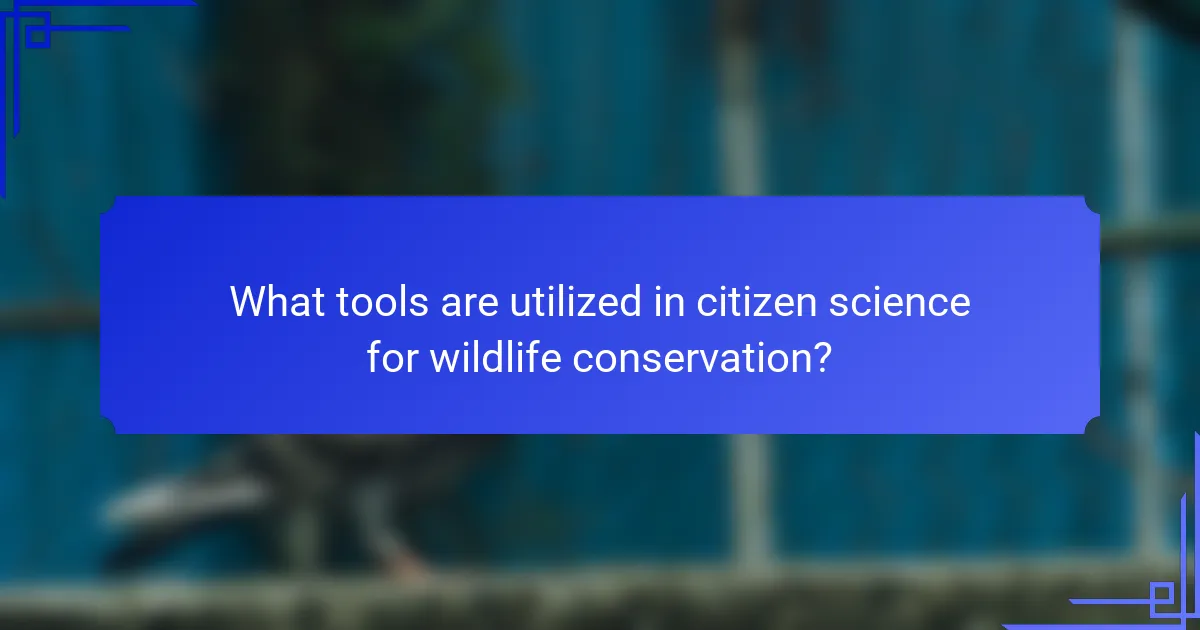
What tools are utilized in citizen science for wildlife conservation?
Citizen science for wildlife conservation utilizes various tools. These tools include mobile applications for data collection, such as iNaturalist and eBird. They enable users to record observations of species and share them with researchers. Camera traps are also commonly used to capture images of wildlife in their natural habitats. GPS devices help track animal movements and migration patterns. Online platforms facilitate collaboration among citizen scientists and researchers. Social media groups raise awareness and engage communities in conservation efforts. Data analysis software assists in interpreting the collected information. These tools enhance the effectiveness of conservation initiatives by involving the public in scientific research.
Which technology platforms support citizen science initiatives?
Technology platforms that support citizen science initiatives include iNaturalist, Zooniverse, and eBird. iNaturalist allows users to document biodiversity through photographs and observations. Zooniverse offers various projects for data collection and analysis across multiple disciplines. eBird enables bird watchers to report sightings and contribute to ornithological research. These platforms facilitate collaboration between scientists and the public. They enhance data collection by leveraging the power of community involvement. Each platform provides tools for users to engage with scientific research actively. This engagement contributes to significant conservation efforts and biodiversity monitoring.
How do mobile apps facilitate data collection in wildlife studies?
Mobile apps facilitate data collection in wildlife studies by enabling real-time reporting and data entry. They provide user-friendly interfaces for citizens to document wildlife sightings. This can include photographs, location data, and behavioral observations. The use of GPS technology ensures accurate location tracking. Mobile apps also often include built-in identification tools for species recognition. This increases the quality and reliability of the data collected. Research indicates that citizen science platforms utilizing mobile apps have significantly increased data volume. For example, the iNaturalist app has contributed millions of observations globally, enhancing biodiversity databases. This widespread participation fosters greater community engagement in conservation efforts.
What role do social media and online platforms play in citizen science?
Social media and online platforms serve as vital tools in citizen science. They facilitate communication and collaboration among researchers and volunteers. These platforms enable the sharing of data, findings, and experiences in real-time. For instance, social media can mobilize community involvement in wildlife monitoring projects. Online platforms provide access to user-friendly tools for data collection. This accessibility encourages broader participation from diverse demographics. Research shows that citizen science projects leveraging social media see increased engagement and data quality. A study published in “Frontiers in Ecology and the Environment” found that social media outreach significantly boosts participant recruitment. Thus, social media and online platforms enhance the effectiveness and reach of citizen science initiatives.
What methodologies are commonly used in citizen science projects?
Common methodologies used in citizen science projects include data collection, monitoring, and analysis. Data collection often involves volunteers gathering information on wildlife sightings or environmental conditions. Monitoring methodologies may include tracking species populations or habitat changes over time. Analysis methods often rely on statistical tools to interpret the data collected by volunteers. These methodologies empower communities to contribute to scientific research. They also enhance public engagement in conservation efforts. Projects like the Great Backyard Bird Count exemplify these methodologies in action. Such initiatives have resulted in significant data contributions to ornithology.
How do researchers ensure data quality and reliability in citizen science?
Researchers ensure data quality and reliability in citizen science through standardized protocols and training. They provide clear guidelines for data collection to minimize variability. Researchers often implement validation processes to cross-check citizen-collected data against expert assessments. Regular feedback is given to citizen scientists to improve accuracy. Data management systems are employed to track and manage contributions effectively. They also utilize statistical methods to assess data quality and identify outliers. Peer review and collaboration with academic institutions enhance credibility. These measures collectively strengthen the integrity of citizen science data used in wildlife conservation efforts.
What are the best practices for designing effective citizen science projects?
Effective citizen science projects should prioritize clear objectives and community engagement. Defining specific goals guides project design and participant involvement. Engaging local communities fosters ownership and increases participation. Providing training ensures participants understand their roles and the scientific methods involved. Utilizing accessible technology facilitates data collection and sharing. Regular feedback keeps participants motivated and informed about project progress. Ensuring data quality through standardized protocols enhances reliability. Lastly, communicating results to participants and stakeholders builds trust and encourages future involvement. These practices contribute to the overall success and sustainability of citizen science initiatives in wildlife conservation.
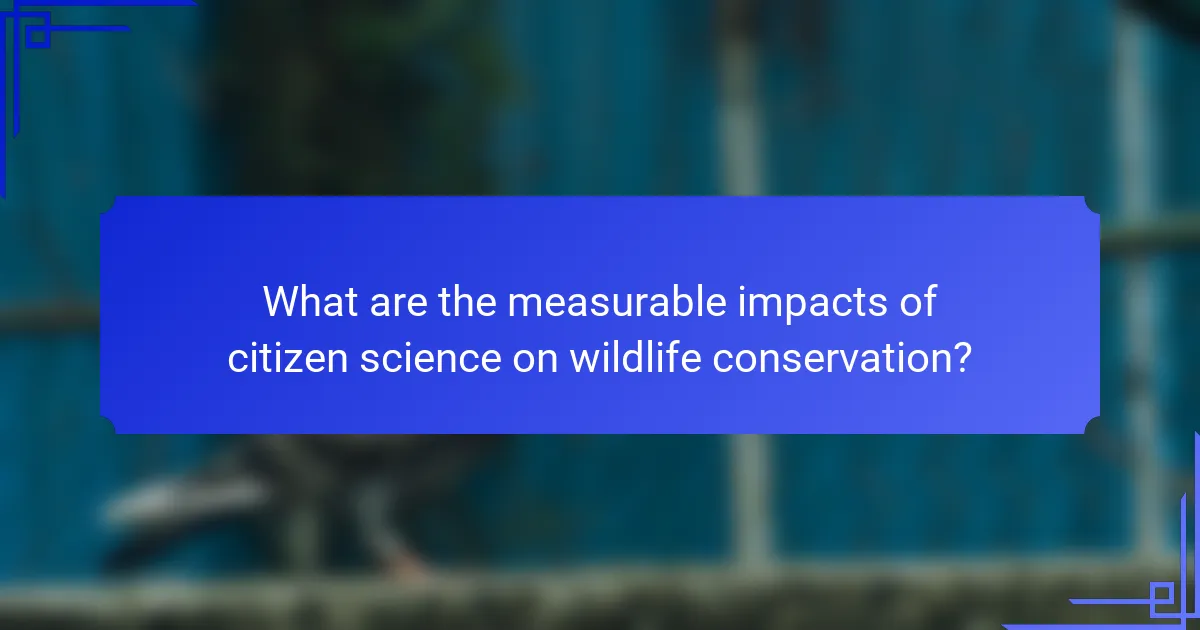
What are the measurable impacts of citizen science on wildlife conservation?
Citizen science significantly impacts wildlife conservation by enhancing data collection and public engagement. It allows volunteers to contribute to biodiversity monitoring, which improves the accuracy of species population assessments. For example, the Global Biodiversity Information Facility reported over 1 billion species records contributed by citizen scientists. This data helps identify trends in species distribution and abundance. Moreover, citizen science fosters community involvement in conservation efforts. Studies indicate that engaged communities are more likely to support and participate in conservation initiatives. The involvement of citizen scientists has led to the successful recovery of endangered species, such as the California condor, through monitoring and habitat restoration projects. Overall, citizen science creates a collaborative approach that strengthens wildlife conservation efforts.
How has citizen science influenced conservation policy and decision-making?
Citizen science has significantly influenced conservation policy and decision-making. It engages the public in data collection and monitoring efforts. This grassroots involvement provides valuable data that informs policy decisions. For instance, studies show that citizen-collected data can enhance the accuracy of species population assessments. Research by Theobald et al. (2015) in “Citizen Science: A Tool for Conservation” highlights how citizen science initiatives have led to the implementation of new conservation strategies. Additionally, citizen science fosters community support for conservation policies. Engaging local populations helps ensure that policies are culturally relevant and more likely to succeed. Overall, citizen science acts as a bridge between scientific research and community engagement, shaping effective conservation outcomes.
What case studies demonstrate successful outcomes from citizen science initiatives?
Successful outcomes from citizen science initiatives include the Great Backyard Bird Count and the Monarch Watch program. The Great Backyard Bird Count engages volunteers in counting bird species, leading to valuable data on bird populations. This initiative has provided insights into migratory patterns and population declines over the years.
Monarch Watch involves citizens in tracking monarch butterfly migrations. Participants tag butterflies, contributing to research on their migration routes and habitat needs. This data has been crucial for conservation efforts aimed at protecting monarch habitats.
Both case studies highlight how citizen involvement can enhance scientific research and inform conservation strategies.
How do citizen science projects contribute to long-term ecological research?
Citizen science projects enhance long-term ecological research by providing extensive data collection over time. They engage non-professionals in monitoring biodiversity and environmental changes. This grassroots involvement increases data volume and geographic coverage. For instance, the Global Biodiversity Information Facility has amassed millions of records from citizen contributions. Such projects often fill gaps in data that professional scientists may overlook. They also foster public awareness and education about ecological issues. Research indicates that citizen-collected data can be as reliable as that from trained scientists. This collaboration strengthens the overall quality of ecological research.
What challenges do citizen science projects face in wildlife conservation?
Citizen science projects in wildlife conservation face several challenges. One major challenge is data quality. Volunteers may lack the expertise needed for accurate data collection. This can lead to inconsistent or unreliable results. Another issue is participant engagement. Sustaining interest over time can be difficult. Many volunteers may drop out after initial participation. Additionally, funding is often limited. Many projects rely on grants or donations, which can be unpredictable. Coordination among diverse participants can also pose difficulties. Effective communication is essential but can be challenging with varying levels of commitment. Lastly, there can be ethical concerns regarding wildlife disturbance. Citizen scientists may inadvertently disrupt habitats or species during data collection. These challenges can hinder the effectiveness of citizen science in wildlife conservation.
How can citizen science initiatives overcome barriers to participation?
Citizen science initiatives can overcome barriers to participation by enhancing accessibility and providing education. Simplifying project tasks makes participation easier for diverse audiences. Offering training sessions helps participants feel more confident in their contributions. Utilizing mobile applications increases engagement by allowing data collection on-the-go. Creating partnerships with local organizations expands outreach and builds community trust. Providing incentives, such as recognition or rewards, motivates individuals to join. Addressing language and cultural differences fosters inclusivity in participation. Research shows that these strategies significantly increase volunteer involvement in citizen science projects.
What strategies can be implemented to enhance data accuracy in citizen science?
Implementing standardized protocols enhances data accuracy in citizen science. Standardized protocols ensure consistent data collection methods among participants. Training volunteers on these protocols improves understanding and execution. Using technology, such as mobile apps, can facilitate real-time data entry and validation. Regular feedback loops help volunteers correct mistakes and improve future data collection. Collaborating with experts can provide oversight and ensure data quality. Data verification processes, including cross-checking with existing datasets, can identify discrepancies. Studies show that these strategies significantly reduce errors and enhance the reliability of citizen science data.
What are the best practices for engaging in citizen science for wildlife conservation?
Engaging in citizen science for wildlife conservation involves several best practices. First, clearly define the project’s goals and objectives. This helps participants understand their roles and the significance of their contributions. Next, provide comprehensive training and resources to ensure participants are well-equipped to collect data accurately.
Utilize user-friendly technology and platforms for data collection. This enhances participation and improves the quality of data gathered. Encourage regular communication with participants to maintain motivation and engagement. Acknowledge and celebrate participants’ contributions to foster a sense of community.
Finally, share the results and impact of the project with participants. This transparency builds trust and encourages ongoing involvement. These practices enhance the effectiveness of citizen science initiatives in wildlife conservation.
Citizen science is a collaborative approach that engages the public in wildlife conservation efforts through data collection and monitoring. This article explores the critical roles citizen science plays in enhancing biodiversity monitoring, promoting community awareness, and influencing conservation policies. It details the tools and methodologies utilized in citizen science projects, such as mobile apps and online platforms, while also addressing challenges like data quality and participant engagement. Additionally, the article highlights successful case studies and best practices for effective citizen science initiatives, showcasing the measurable impacts on wildlife conservation.
